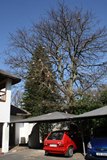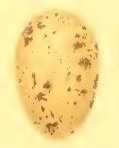Weaver species
Choose different species from drop-down list and press 'Go' button. See Full species list.Blue-billed Malimbe Malimbus nitens
IUCN: Least concern Discovery: 035Categories: Malimbus, fruit, palm,
News items about species
Discovery
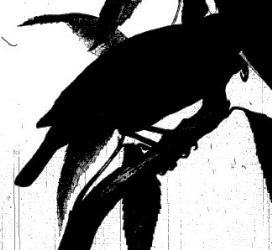
figure from Gray 1849 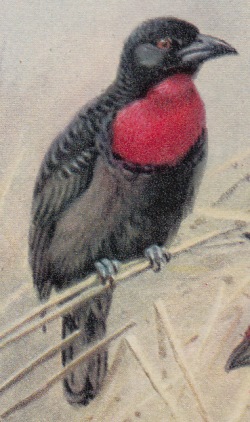
figure from Bannerman 1949 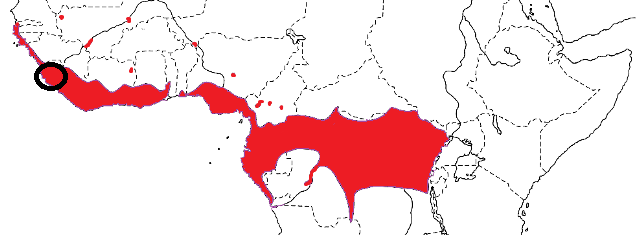
distribution, type locality circled IntroductionThe Blue-billed Malimbe was formally described by George Robert Gray, an English zoologist, author, and head of the ornithological section of the British Museum. Gray started at the British Museum as Assistant Keeper of the Zoology Branch in 1831, when he would have found the specimen brought to the museum years earlier.The Blue-billed Malimbe had been collected by Captain Edward Sabine, an Irish astronomer, geophysicist, ornithologist, explorer, and soldier. Sabine travelled halfway around the world to study the the "oblateness" (shape) of the Earth and carried out measurements on the intertropical coasts of Africa and the Americas. Sabine had struck up a friendship with Douglas Clavering, an officer of the British Royal Navy, who agreed to take Sabine on board the Pheasant. They travelled to Sierra Leone, the Island of St Thomas, Ascension Island, Bahia, Maranham, Trinidad, Jamaica, and New York during the years 1821-23. The first illustration of a Blue-billed Malimbe is in Gray (1849), although it is a poor illustration (the original may be in colour, the internet scanned version is not). The next potential illustration is by Reichenbach (1863), who illustrated most weavers known at that time - he described 3 malimbes but the paintings of these species do not appear to have been published. This species was not illustrated again until Bannerman (1949). Scientific citationPloceus nitens Gray 1831; Zool. Misc., 1, p.7; Sierra Leone (cf. Sharpe, 1890, Cat. Birds Brit. Mus., 13, p.481).Meaning of namesnitens Latin: shining, glittering (nitere, to shine).First English nameRed-breasted Weaver (Gray 1831).Alternate namesRed-breasted Weaver, The shining Malimbus, Lake Albert Malimbe, Gray's Blue-billed Weaver, Great Blue-billed Weaver.CollectorCaptain Edward Sabine.Date collectedBetween 1821 - 1823.Locality collectedSierra Leone.Type specimensOne type specimen is in the British Museum (BM Old Vellum Cat. 21 no. 82a). |
The above is based on Weaver Wednesday 2, a weekly series about the discovery of each weaver species.
This species text first appeared as
Weaver Wednesday [152] - Discovery [35]: Blue-billed Malimbe on 2015-05-13
1. Basic biology
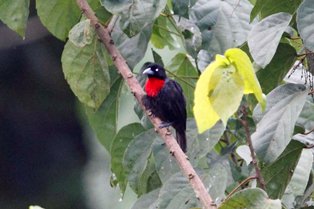
figure from PHOWN 984 Distribution. The Blue-billed Malimbe is found from Senegal to western Uganda and northern Angola, as shown in the map (below, from Birds of Africa). It has no subspecies, although two were proposed in the past. Habitat. The Blue-billed Malimbe inhabits primary, logged and mature old secondary lowland forest, keeping largely to the undergrowth. It is also found in riverine forest and dense thickets near water, or in swamp forest. The Blue-billed Malimbe is solitary or found in pairs or family parties. 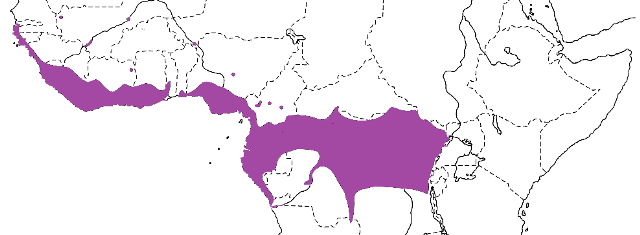 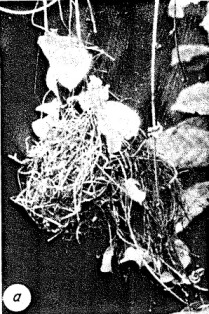
figure from Collias & Collias 1964 Food. The Blue-billed Malimbe feeds on a wide variety of arthropods, including larvae, grubs, chrysalises, caterpillars, ants, hemipterans, grasshoppers, small beetles, butterflies and spiders. It sometimes feeds on seeds or oil palm fruits. It climbs tree limbs like a woodpecker, while foraging for arthropods. Breeding.
This species is monogamous and the male builds a new nest every season. Old nests may survive for several years so that a few nests may be clustered nearby. Sometimes several pairs form loose colonies. The nest is ball-shaped, made of strips of epiphytes, palm fibres, twigs and tendrils (see photo right, from Collias NE, Collias EC. 1964. Evolution of nest building in weaverbirds. Univ. Calif. Publ. Zool. 73:1-239). The nests often overhang forest rivers and ponds. The entrance tunnel is not very long, as in the nests of some malimbes.
The eggs are pale with darker markings, and incubation is by the female only. A remarkable nesting association has been found in this species. They like to build their nests in the vicinity of dens of the Central African Dwarf Crocodile Osteolaemus tetraspis, presumably because the presence of crocodiles keeps predators away. |
The above is based on Weaver Wednesday, a weekly series about weaver species.
This species text first appeared as
Weaver Wednesday [12]: Blue-billed Malimbe on 2012-09-05
2. Breeding facts
| Pair bond Monogamous Breeding season Jan-Jul in Senegal, Nov-Mar in Liberia, Jun-Mar in Ivory Coast, Jun-Jul and Sept-Oct in Ghana, Apr and Jul in Togo, Feb-Nov (mainly Apr-Jul) in Nigeria, May-Jun and Sept-Oct in Cameroon, Dec-Mar in Gabon; in all months except Apr and Aug in DRCongo, in Nov and Mar in Uganda, and Feb-Apr in Angola Nest site generally suspended from palm frond or small bush 0.4-3 m above forest stream or pool (one site abandoned when pool dried up), rarely in dry forest and then up to 10 m above ground Nest building built by male only Colony size Mostly solitary nester, and territorial; in Ghana also loose colonies of 5-21 nests (average 10 at six sites), with up to six of these occupied Clutch size 2 eggs (average of 25 clutches) Egg colour whitish, grey, pale green or creamy-brown ground colour, large brown spots forming ring at thick end, sometimes salmon-pink with reddish spots (colour type apparently specific to individual females) Egg size average size of nine eggs 24.3 x 16.1 mm (Cameroon and DRCongo) Incubation incubation by female only, often absent from nest for extended periods, male perched nearby, gave alarm call when predators approached, incubation period 14 days Chicks and nestling period chicks fed by both sexes, nestling period 16 days |
Breeding information based on Handbook of the Birds of the World, Vol. 15.
3. Photos of Weaver Nests
 Vm 13823 |  Vm 5334 |  Vm 984 |
Thumb-nails of most recent PHOWN records - click on one to see its full record
See all PHOWN records for this species here.
PHOWN (Photos of Weaver Nests) provides valuable info on breeding distribution and colony sizes of weavers.
You can contribute by registering and submitting photos at Virtual Museum webpage.
4. Breeding distribution
Google map showing distribution (For species with small ranges you need to zoom in at the correct area to see the range):
yellow blob - range of weaver species; read more about this here.
![]() - PHOWN records with photos
- PHOWN records with photos
![]() - PHOWN records with no photos (Nest Record Cards, other records)
- PHOWN records with no photos (Nest Record Cards, other records)
![]() - Birdpix records
- Birdpix records
![]() - comments on out of range records, or interesting records
- comments on out of range records, or interesting records
![]() - type locality
- type locality
CLICK on the marker on the map to see individual record details.
5. Range changes
Not South African speciesThe above is based on Weaver Wednesday 3, a weekly series about range changes in South African weaver species.
This species text first appeared as
n/a








